Modular Microfactories Market
Modular Microfactories Market Analysis, By Footprint/Scale, By End-Use Industry, By Core Technology, By Business Model, and Region - Market Insights 2025 to 2035
The Capital Purchase segment is projected to grow at a CAGR of 13.7%, whereas another segment Microfactory-as-a-Service (MaaS) is likely to grow at 17.3%. In terms of countries US is projected to grow at 16.0%, followed by China at 16.4% and Germany to grow at 15.7%.
Modular Microfactories Market Outlook (2025 to 2035)
The global Modular Microfactories Market is expected to reach USD 23.2 billion by 2035, up from USD 4.8 billion in 2024. During the forecast period 2025 to 2035, the industry is projected to grow at a CAGR of 15.4%.
Over the next ten years, the industry is poised to grow 4.0 times, with an absolute dollar opportunity of USD 17.7 billion. Industry 4.0 integration, decentralized manufacturing, and increased investment in compact, flexible microfactory setups are notable trends. Meanwhile, the rising demand for localized and cost-effective production, as well as the adoption of sustainability and automation, is a key driver paving the way for modular microfactories.
The modular microfactories market comprises compact, automated manufacturing units designed for localized, scalable, and efficient production using advanced technologies such as AI, the Internet of Things, robotics, and digital tools.
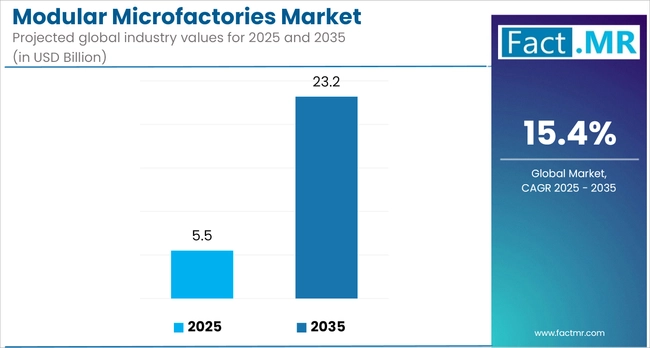
What are the drivers of the modular microfactories market?
The manufacturing industry is transforming beyond the periphery of Industry 4.0 and ultimate customization. Razor-thin product distinction as a result of increased expectations for personalization and efficient manufacturing. As more people demand customization, producers utilize modular microfactories for rapid prototyping and manufacturing in small lot sizes. Fast-paced industries such as fashion, consumer electronics, and automotive make these units highly effective, as businesses in these sectors require faster changes and quicker access to the modular microfactories market.
Adopting advanced technologies of Industry 4.0 also plays an important role. The use of AI, robotics, machine learning, and connected systems in modern microfactories enables real-time tracking, predictive maintenance, and the full automation of processes. Because of these technological improvements, manufacturing operations are more efficient, cause fewer errors and make the process simpler.
Using eco-friendly approaches is becoming very important. Microfactories are environmental friendly as they cause less pollution, are local and are good at using resources. Being small helps the businesses reduce waste, and being nearby to consumers lowers the need for products to be transported great distances.
Recent challenges with the global supply chain are prompting companies to leverage decentralization as a key advantage. Microfactories near customer centers make companies more flexible, save time and enable quicker delivery. Strategies and rewards implemented by government bodies are also helping the market grow, supporting innovation and regional manufacturing.
What are the regional trends of the modular microfactories market?
Strong investment in advanced manufacturing systems is driving the popularity of modular microfactories in North America. The USA and Canada are moving towards more domestic production, assisted by the USA CHIPS and Science Act, which motivates companies to stay and develop new technologies locally. Pilot microfactories are being built in the Midwest and Southern states, primarily in the automotive, aerospace, and electronics sectors, to enhance the supply chain’s speed and durability.
In Europe, the large-scale use of microfactories for the fourth industrial and green manufacturing process is being spearheaded by Germany, the UK and the Netherlands. As the EU promotes carbon-neutral production, regions are now utilizing space-saving power units. Microfactory projects for precision engineering are being explored in Germany’s Mittelstand sector, and the UK relies on microfactories to strengthen its manufacturing of electronics and medical devices.
The Asia-Pacific region is growing rapidly, primarily driven by China, India, and Southeast Asia. To cope with greater demand and to support their country’s national goals, these countries are adopting systems for microfactories. China aims to boost its economy and alleviate urban congestion by promoting microfactories in smaller cities.
They indicate that the globe is shifting toward flexible production methods, adapted to each region and more sustainable.
What are the challenges and restraining factors of the modular microfactories market?
A major problem in the modular microfactories industry is that starting up and integrating advanced systems such as robotics, AI, and IoT is very expensive. In these places, small and medium-sized enterprises (SMEs) may not be able to afford the upfront costs that offer significant rewards in the long run.
Skilled resource availability is yet another important factor. Operating and managing advanced modular systems requires an understanding of automation, data analysis, and systems engineering, which is still lacking in much of the world.
Also, difficulties with regulations and guidelines may impede the deployment of new projects. Due to varying regulations worldwide and complex compliance procedures, it is challenging for companies to expand into different countries.
Due to the lack of awareness and openness to change among traditional manufacturers, this is also a significant issue. Many organizations are reluctant to transition from conventional systems to a modular approach because they perceive it as risky or unfamiliar.
Another issue is that it is less convenient to reach and handle relocatable microfactories in remote or undeveloped areas, which leads to additional challenges and results in their slower global spread.
Country-Wise Insights
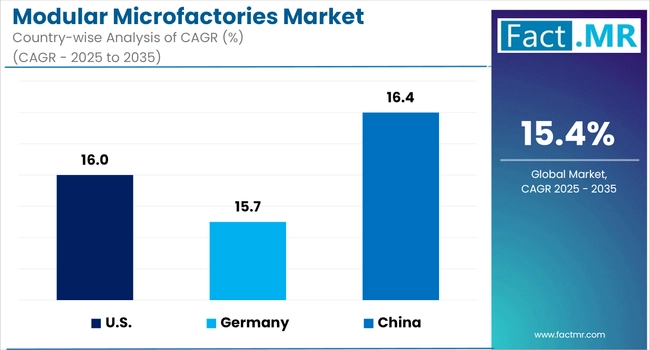
United States: Pioneering Modular Microfactories for Agile, Sustainable Manufacturing
America is a leader in developing modular microfactories, improving disaster-relief structures, car production and 3D printing. Businesses are collaborating with AI and robotics to develop microfactories for the rapid and efficient production of housing and vehicle components. Their small size makes them precious in areas with few houses, since off-site prefabricated houses can be prepared fast. Primarily, local furniture and large component manufacturers now utilize automated modular systems to reduce timeframes and make the manufacturing process more sustainable.
Microfactory-as-a-service models are gaining popularity in the USA, allowing production to occur wherever and whenever it is needed. Through this approach, they support the continuity of the supply chain by not relying heavily on a single central manufacturer or mode of transport. The construction, electric vehicle, and consumer product industries are among the sectors driving the shift, due to aims for personalization, a desire to move some production back to their home countries, and a commitment to better care for the environment.
Germany excels in AI-integrated microfactories
Germany has become a leading player in the field of modular microfactories due to its precision engineering and automation capabilities. There are now many modular manufacturing systems that combine CNC machines, robots, and easy-to-use flexibility in Germany. Research institutions, as well as specialized manufacturers, are currently developing scalable microfactories that integrate with existing digital manufacturing platforms. The structures make it easy to change and produce products in small amounts, which agrees with Germany’s focus on advanced engineering.
New trends involve installing microfactory stations within traditional factories, allowing for manufacturing to be adjusted and updated as needed. More enterprises are adopting AI-driven IoT technologies to ensure their businesses run more efficiently, perform predictive maintenance, and meet their objectives for minimizing waste. Since national strategies focus on reducing emissions and advancing industry, the automotive, high-precision tooling, and sustainable machining sectors are embracing local micro-manufacturing.
China: Scaling Smart Modular Manufacturing with AI and Digital Innovation
China is swiftly growing its role in the modular microfactory world, because of its interest in smart and local manufacturing. The government encouraging digital progress in the manufacturing industry has caused the broad use of modular cells in electronics, automotive parts and consumer goods. To supply goods quickly and customize them, these microfactories are strategically located near other industries.
AI, 5G, and edge computing are being combined in the equipment used in factory modules in China. Because of this, data is recorded immediately, the system can be easily redesigned, and low-batch production is possible. The use of cloud-linked, digital twin-enabled microfactories enables production to be localized, making it easier to adjust manufacturing activities quickly. As a result, China is emerging as a global leader in smart modular manufacturing.
Category-Wise Analysis
By Footprint/Scale - Containerized Microfactories Dominate Due to Portability and Rapid Deployment
Containerized microfactories have enhanced flexible manufacturing by allowing them to be deployed quickly inside shipping containers, making them portable, adjustable, and suitable for decentralized manufacturing. Microfactories are commonly used where mobility, the ability to change and quick setup are critical. Because they are easy to set up, they enable users to produce electricity wherever needed, even in cities or remote locations, without the need for installed structures. This packaging method is commonly used for supplying disaster zones, military locations, and off-the-grid areas.
Nowadays, container units are working with renewable energy, cloud-based controls and real-time monitoring. In some markets, whether advanced or not, the costs of building conventional factories are deterring companies from pursuing this route, which is why they are increasingly opting for mobile factories. As customers demand more local manufacturing following COVID-19, these microfactories are also playing a crucial role in bringing manufacturing back to their native countries, thereby reducing both lead times and emissions.
Additionally, to leverage modern technology, more containerized setups now incorporate hybrid features, including 3D printing and CNC machining. Both governments and OEMs are supporting pilot programs that focus on flexible, adaptable, and efficient manufacturing, designed to align with Industry 4.0 and eco-friendly goals.
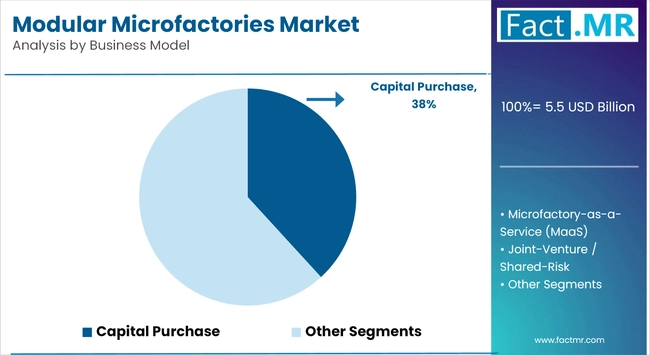
By End-Use Industry - Automotive & Transportation Lead Market Penetration
Most of the demand in modular microfactories is driven by the transportation and automotive industries, as they consistently focus on lean manufacturing, customization, and technology. Many significant automakers and key suppliers are now utilizing microfactories to manufacture EV parts, interiors, battery packs, and lightweight components locally. Thanks to these units, build-to-order strategies are possible which leads to fewer inventory costs and the ability to produce vehicles regionally for the global market.
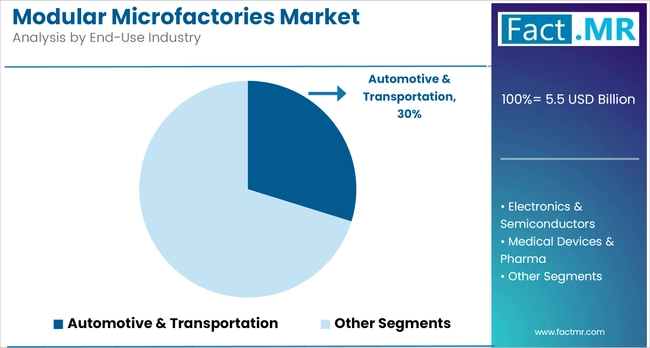
The shift to electric cars is a major change here and because these specialized parts are now made in smaller volumes, this means traditional mass-production lines cannot be used. Producing small volumes can be safer and cost less in containerized or modular microfactories which makes them suitable for people testing out EV startups and new concepts.
Competitive Analysis
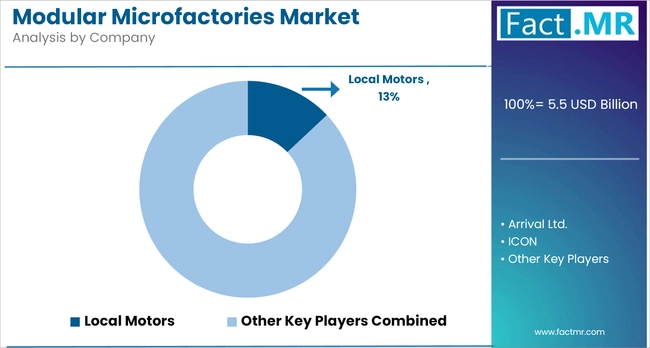
Key players in the modular microfactories industry include Local Motors, StreetScooter, Arrival Ltd., FlexCell Inc., MicroFab Solutions GmbH, Zenith Robotics Co., AdvancedX Systems, Industrial 4.0 Integration (I4I), Asia Modular Manufacturing (AMM), CEAD Group, ICON, Reframe Systems, ChopValue, Velox Consultants Consortium, Rodinia Generation, Bright Machines.
The use of modular microfactories is growing in the automotive, consumer electronics, construction and furniture manufacturing industries. People are choosing these small, independent production facilities for bringing manufacturing to the area, reducing shipping costs and designing quickly. The adoption of Industry 4.0 technologies, such as IoT, AI-driven automation, and digital twins, is transforming these compact sites into smart and responsive production areas. Using sustainable practices remains crucial, and many are incorporating recycled materials and reducing their energy consumption.
Smart and adaptable microfactories are becoming popular because they handle production in small quantities and on a customized basis. More players are entering the market in Asia and North America, which is intensifying the competition. Moreover, working with robotic firms and software companies is transforming the value chains, allowing automation and modularity to be applied at higher volumes. This transformation is preparing for changes that could transform usual factory businesses.
Recent Development
- In March 2025, Bright Machines unveiled Bright Designer, a web-based tool enabling engineers to design, simulate, and test automated manufacturing processes for microfactories. Integrated with Brightware, the platform reduced design cycles and enhanced smart production planning. Offering real-time feedback and adaptive workflows, it improved flexibility and cost efficiency for small-batch and just-in-time manufacturing across various industries. The innovation strengthened agile, decentralized production capabilities.
- In April 2025, Local Motors deployed the world’s largest composite 3D printer, the Thermwood LSAM (10’×40’), at its Knoxville facility. The machine enabled rapid, full-scale production of parts for its autonomous shuttle, Olli, while cutting material waste and fabrication time. This advancement reinforced Local Motors’ leadership in decentralized, sustainable manufacturing and large-format additive manufacturing for electric vehicles.
Fact.MR has provided detailed information about the price points of key manufacturers of the Modular Microfactories Market, positioned across regions, including sales growth, production capacity, and speculative technological expansion, in the recently published report.
Segmentation of Modular Microfactories Market
-
By Footprint/Scale :
- Desktop/Benchtop Microcells
- Containerized Microfactories
- Small-Shop Microfactories
- Modular Campus Units
-
By End-Use Industry :
- Automotive & Transportation
- Electronics & Semiconductors
- Medical Devices & Pharma
- Aerospace & Defense
- Consumer Goods & Apparel
- Food & Beverage (F&B)
-
By Core Technology :
- Subtractive & Metal-Fab Cells (CNC, laser cutting)
- Additive Manufacturing Cells (3D printing, hybrid)
- Robotic Assembly & Kitting Cells
- Quality Inspection Modules (AOI, CMM
- Cleanroom/Pharma Fill-Finish Units
- Packaging & Logistics Cells
-
By Business Model :
- Capital Purchase
- Microfactory-as-a-Service (MaaS)
- Joint-Venture / Shared-Risk
- Build-Operate-Transfer (BOT)
-
By Region :
- North America
- Latin America
- Western Europe
- Eastern Europe
- East Asia
- South Asia & Pacific
- Middle East & Africa
Table of Content
- Executive Summary
- Industry Introduction, including Taxonomy and Market Definition
- Market Trends and Success Factors, including Macro-economic Factors, Market Dynamics, and Recent Industry Developments
- Global Market Demand Analysis 2020 to 2024 and Forecast 2025 to 2035, including Historical Analysis and Future Projections
- Pricing Analysis
- Global Market Analysis 2020 to 2024 and Forecast 2025 to 2035
- Footprint/Scale
- End-Use Industry
- Core Technology
- Business Model
- Global Market Analysis 2020 to 2024 and Forecast 2025 to 2035, By Footprint/Scale
- Desktop/Benchtop Microcells
- Containerized Microfactories
- Small-Shop Microfactories
- Modular Campus Value (USD Bn) & Units
- Global Market Analysis 2020 to 2024 and Forecast 2025 to 2035, By End-Use Industry
- Automotive & Transportation
- Electronics & Semiconductors
- Medical Devices & Pharma
- Aerospace & Defense
- Consumer Goods & Apparel
- Food & Beverage (F&B)
- Global Market Analysis 2020 to 2024 and Forecast 2025 to 2035, By Core Technology
- Subtractive & Metal-Fab Cells (CNC, laser cutting)
- Additive Manufacturing Cells (3D printing, hybrid)
- Robotic Assembly & Kitting Cells
- Quality Inspection Modules (AOI, CMM)
- Cleanroom/Pharma Fill-Finish Value (USD Bn) & Units
- Packaging & Logistics Cells
- Global Market Analysis 2020 to 2024 and Forecast 2025 to 2035, By Business Model
- Capital Purchase
- Microfactory-as-a-Service (MaaS)
- Joint-Venture / Shared-Risk
- Build-Operate-Transfer (BOT)
- Global Market Analysis 2020 to 2024 and Forecast 2025 to 2035, By Region
- North America
- Latin America
- Western Europe
- South Asia
- East Asia
- Eastern Europe
- Middle East & Africa
- North America Sales Analysis 2020 to 2024 and Forecast 2025 to 2035, by Key Segments and Countries
- Latin America Sales Analysis 2020 to 2024 and Forecast 2025 to 2035, by Key Segments and Countries
- Western Europe Sales Analysis 2020 to 2024 and Forecast 2025 to 2035, by Key Segments and Countries
- South Asia Sales Analysis 2020 to 2024 and Forecast 2025 to 2035, by Key Segments and Countries
- East Asia Sales Analysis 2020 to 2024 and Forecast 2025 to 2035, by Key Segments and Countries
- Eastern Europe Sales Analysis 2020 to 2024 and Forecast 2025 to 2035, by Key Segments and Countries
- Middle East & Africa Sales Analysis 2020 to 2024 and Forecast 2025 to 2035, by Key Segments and Countries
- Sales Forecast 2025 to 2035 by Footprint/Scale, End-Use Industry, Core Technology, and Business Model for 30 Countries
- Competition Outlook, including Market Structure Analysis, Company Share Analysis by Key Players, and Competition Dashboard
- Company Profile
- Local Motors
- StreetScooter
- Arrival Ltd.
- FlexCell Inc.
- MicroFab Solutions GmbH
- Zenith Robotics Co
- AdvancedX Systems
- Industrial 4.0 Integration (I4I)
- Asia Modular Manufacturing (AMM)
- CEAD Group
- ICON
- Reframe Systems
- ChopValue
- Other Market Players
List Of Table
- Table 1: Global Market Value (USD Bn) & Units Forecast by Region, 2020 to 2035
- Table 2: Global Market Value (USD Bn) & Units Forecast by Footprint/Scale, 2020 to 2035
- Table 3: Global Market Value (USD Bn) & Units Forecast by End-Use Industry, 2020 to 2035
- Table 4: Global Market Value (USD Bn) & Units Forecast by Core Technology, 2020 to 2035
- Table 5: Global Market Value (USD Bn) & Units Forecast by Business Model, 2020 to 2035
- Table 6: North America Market Value (USD Bn) & Units Forecast by Country, 2020 to 2035
- Table 7: North America Market Value (USD Bn) & Units Forecast by Footprint/Scale, 2020 to 2035
- Table 8: North America Market Value (USD Bn) & Units Forecast by End-Use Industry, 2020 to 2035
- Table 9: North America Market Value (USD Bn) & Units Forecast by Core Technology, 2020 to 2035
- Table 10: North America Market Value (USD Bn) & Units Forecast by Business Model, 2020 to 2035
- Table 11: Latin America Market Value (USD Bn) & Units Forecast by Country, 2020 to 2035
- Table 12: Latin America Market Value (USD Bn) & Units Forecast by Footprint/Scale, 2020 to 2035
- Table 13: Latin America Market Value (USD Bn) & Units Forecast by End-Use Industry, 2020 to 2035
- Table 14: Latin America Market Value (USD Bn) & Units Forecast by Core Technology, 2020 to 2035
- Table 15: Latin America Market Value (USD Bn) & Units Forecast by Business Model, 2020 to 2035
- Table 16: Western Europe Market Value (USD Bn) & Units Forecast by Country, 2020 to 2035
- Table 17: Western Europe Market Value (USD Bn) & Units Forecast by Footprint/Scale, 2020 to 2035
- Table 18: Western Europe Market Value (USD Bn) & Units Forecast by End-Use Industry, 2020 to 2035
- Table 19: Western Europe Market Value (USD Bn) & Units Forecast by Core Technology, 2020 to 2035
- Table 20: Western Europe Market Value (USD Bn) & Units Forecast by Business Model, 2020 to 2035
- Table 21: South Asia Market Value (USD Bn) & Units Forecast by Country, 2020 to 2035
- Table 22: South Asia Market Value (USD Bn) & Units Forecast by Footprint/Scale, 2020 to 2035
- Table 23: South Asia Market Value (USD Bn) & Units Forecast by End-Use Industry, 2020 to 2035
- Table 24: South Asia Market Value (USD Bn) & Units Forecast by Core Technology, 2020 to 2035
- Table 25: South Asia Market Value (USD Bn) & Units Forecast by Business Model, 2020 to 2035
- Table 26: East Asia Market Value (USD Bn) & Units Forecast by Country, 2020 to 2035
- Table 27: East Asia Market Value (USD Bn) & Units Forecast by Footprint/Scale, 2020 to 2035
- Table 28: East Asia Market Value (USD Bn) & Units Forecast by End-Use Industry, 2020 to 2035
- Table 29: East Asia Market Value (USD Bn) & Units Forecast by Core Technology, 2020 to 2035
- Table 30: East Asia Market Value (USD Bn) & Units Forecast by Business Model, 2020 to 2035
- Table 31: Eastern Europe Market Value (USD Bn) & Units Forecast by Country, 2020 to 2035
- Table 32: Eastern Europe Market Value (USD Bn) & Units Forecast by Footprint/Scale, 2020 to 2035
- Table 33: Eastern Europe Market Value (USD Bn) & Units Forecast by End-Use Industry, 2020 to 2035
- Table 34: Eastern Europe Market Value (USD Bn) & Units Forecast by Core Technology, 2020 to 2035
- Table 35: Eastern Europe Market Value (USD Bn) & Units Forecast by Business Model, 2020 to 2035
- Table 36: Middle East & Africa Market Value (USD Bn) & Units Forecast by Country, 2020 to 2035
- Table 37: Middle East & Africa Market Value (USD Bn) & Units Forecast by Footprint/Scale, 2020 to 2035
- Table 38: Middle East & Africa Market Value (USD Bn) & Units Forecast by End-Use Industry, 2020 to 2035
- Table 39: Middle East & Africa Market Value (USD Bn) & Units Forecast by Core Technology, 2020 to 2035
- Table 40: Middle East & Africa Market Value (USD Bn) & Units Forecast by Business Model, 2020 to 2035
List Of Figures
- Figure 1: Global Market Value Share (%), Growth Rate (Y-o-Y), and Value (USD Bn) & Units Projection by Footprint/Scale, 2020 to 2035
- Figure 2: Global Market Value Share (%), Growth Rate (Y-o-Y), and Value (USD Bn) & Units Projection by End-Use Industry, 2020 to 2035
- Figure 3: Global Market Value Share (%), Growth Rate (Y-o-Y), and Value (USD Bn) & Units Projection by Core Technology, 2020 to 2035
- Figure 4: Global Market Value Share (%), Growth Rate (Y-o-Y), and Value (USD Bn) & Units Projection by Business Model, 2020 to 2035
- Figure 5: Global Market Value Share (%), Growth Rate (Y-o-Y), and Value (USD Bn) & Units Projection by Region, 2020 to 2035
- Figure 6: North America Market Value Share (%), Growth Rate (Y-o-Y), and Value (USD Bn) & Units Projection by Footprint/Scale, 2020 to 2035
- Figure 7: North America Market Value Share (%), Growth Rate (Y-o-Y), and Value (USD Bn) & Units Projection by End-Use Industry, 2020 to 2035
- Figure 8: North America Market Value Share (%), Growth Rate (Y-o-Y), and Value (USD Bn) & Units Projection by Core Technology, 2020 to 2035
- Figure 9: North America Market Value Share (%), Growth Rate (Y-o-Y), and Value (USD Bn) & Units Projection by Business Model, 2020 to 2035
- Figure 10: North America Market Value Share (%), Growth Rate (Y-o-Y), and Value (USD Bn) & Units Projection by Country, 2020 to 2035
- Figure 11: Latin America Market Value Share (%), Growth Rate (Y-o-Y), and Value (USD Bn) & Units Projection by Footprint/Scale, 2020 to 2035
- Figure 12: Latin America Market Value Share (%), Growth Rate (Y-o-Y), and Value (USD Bn) & Units Projection by End-Use Industry, 2020 to 2035
- Figure 13: Latin America Market Value Share (%), Growth Rate (Y-o-Y), and Value (USD Bn) & Units Projection by Core Technology, 2020 to 2035
- Figure 14: Latin America Market Value Share (%), Growth Rate (Y-o-Y), and Value (USD Bn) & Units Projection by Business Model, 2020 to 2035
- Figure 15: Latin America Market Value Share (%), Growth Rate (Y-o-Y), and Value (USD Bn) & Units Projection by Country, 2020 to 2035
- Figure 16: Western Europe Market Value Share (%), Growth Rate (Y-o-Y), and Value (USD Bn) & Units Projection by Footprint/Scale, 2020 to 2035
- Figure 17: Western Europe Market Value Share (%), Growth Rate (Y-o-Y), and Value (USD Bn) & Units Projection by End-Use Industry, 2020 to 2035
- Figure 18: Western Europe Market Value Share (%), Growth Rate (Y-o-Y), and Value (USD Bn) & Units Projection by Core Technology, 2020 to 2035
- Figure 19: Western Europe Market Value Share (%), Growth Rate (Y-o-Y), and Value (USD Bn) & Units Projection by Business Model, 2020 to 2035
- Figure 20: Western Europe Market Value Share (%), Growth Rate (Y-o-Y), and Value (USD Bn) & Units Projection by Country, 2020 to 2035
- Figure 21: South Asia Market Value Share (%), Growth Rate (Y-o-Y), and Value (USD Bn) & Units Projection by Footprint/Scale, 2020 to 2035
- Figure 22: South Asia Market Value Share (%), Growth Rate (Y-o-Y), and Value (USD Bn) & Units Projection by End-Use Industry, 2020 to 2035
- Figure 23: South Asia Market Value Share (%), Growth Rate (Y-o-Y), and Value (USD Bn) & Units Projection by Core Technology, 2020 to 2035
- Figure 24: South Asia Market Value Share (%), Growth Rate (Y-o-Y), and Value (USD Bn) & Units Projection by Business Model, 2020 to 2035
- Figure 25: South Asia Market Value Share (%), Growth Rate (Y-o-Y), and Value (USD Bn) & Units Projection by Country, 2020 to 2035
- Figure 26: East Asia Market Value Share (%), Growth Rate (Y-o-Y), and Value (USD Bn) & Units Projection by Footprint/Scale, 2020 to 2035
- Figure 27: East Asia Market Value Share (%), Growth Rate (Y-o-Y), and Value (USD Bn) & Units Projection by End-Use Industry, 2020 to 2035
- Figure 28: East Asia Market Value Share (%), Growth Rate (Y-o-Y), and Value (USD Bn) & Units Projection by Core Technology, 2020 to 2035
- Figure 29: East Asia Market Value Share (%), Growth Rate (Y-o-Y), and Value (USD Bn) & Units Projection by Business Model, 2020 to 2035
- Figure 30: East Asia Market Value Share (%), Growth Rate (Y-o-Y), and Value (USD Bn) & Units Projection by Country, 2020 to 2035
- Figure 31: Eastern Europe Market Value Share (%), Growth Rate (Y-o-Y), and Value (USD Bn) & Units Projection by Footprint/Scale, 2020 to 2035
- Figure 32: Eastern Europe Market Value Share (%), Growth Rate (Y-o-Y), and Value (USD Bn) & Units Projection by End-Use Industry, 2020 to 2035
- Figure 33: Eastern Europe Market Value Share (%), Growth Rate (Y-o-Y), and Value (USD Bn) & Units Projection by Core Technology, 2020 to 2035
- Figure 34: Eastern Europe Market Value Share (%), Growth Rate (Y-o-Y), and Value (USD Bn) & Units Projection by Business Model, 2020 to 2035
- Figure 35: Eastern Europe Market Value Share (%), Growth Rate (Y-o-Y), and Value (USD Bn) & Units Projection by Country, 2020 to 2035
- Figure 36: Middle East & Africa Market Value Share (%), Growth Rate (Y-o-Y), and Value (USD Bn) & Units Projection by Footprint/Scale, 2020 to 2035
- Figure 37: Middle East & Africa Market Value Share (%), Growth Rate (Y-o-Y), and Value (USD Bn) & Units Projection by End-Use Industry, 2020 to 2035
- Figure 38: Middle East & Africa Market Value Share (%), Growth Rate (Y-o-Y), and Value (USD Bn) & Units Projection by Core Technology, 2020 to 2035
- Figure 39: Middle East & Africa Market Value Share (%), Growth Rate (Y-o-Y), and Value (USD Bn) & Units Projection by Business Model, 2020 to 2035
- Figure 40: Middle East & Africa Market Value Share (%), Growth Rate (Y-o-Y), and Value (USD Bn) & Units Projection by Country, 2020 to 2035
- FAQs -
What was the Global Modular Microfactories Market Size Reported by Fact.MR for 2025?
The global modular microfactories market was valued at USD 5.5 Billion in 2025.
Who are the Major Players Operating in the Modular Microfactories Market?
Prominent players in the market are Local Motors, StreetScooter, Arrival Ltd., FlexCell Inc., MicroFab Solutions GmbH, among others.
What is the Estimated Valuation of the Modular Microfactories Market in 2035?
The market is expected to reach a valuation of USD 23.2 Billion in 2035.
What Value CAGR did the Modular Microfactories Market Exhibit Over the Last Five Years?
The historic growth rate of the modular microfactories market was 14.8% from 2020 to 2024.